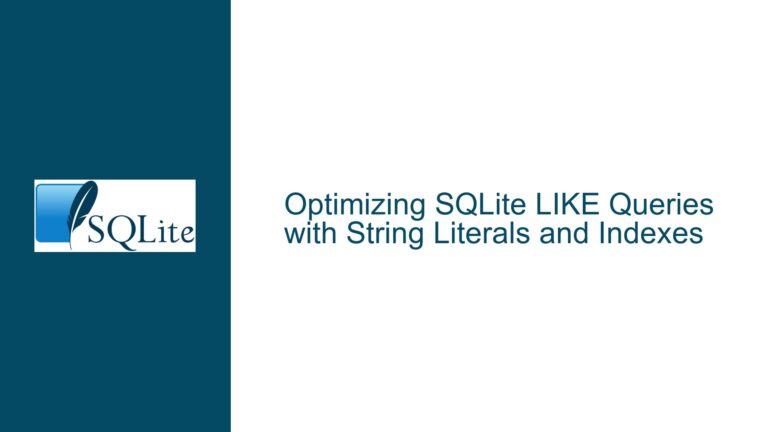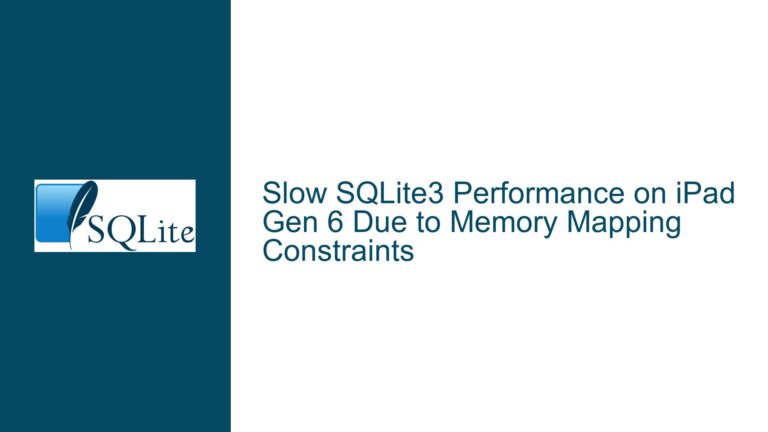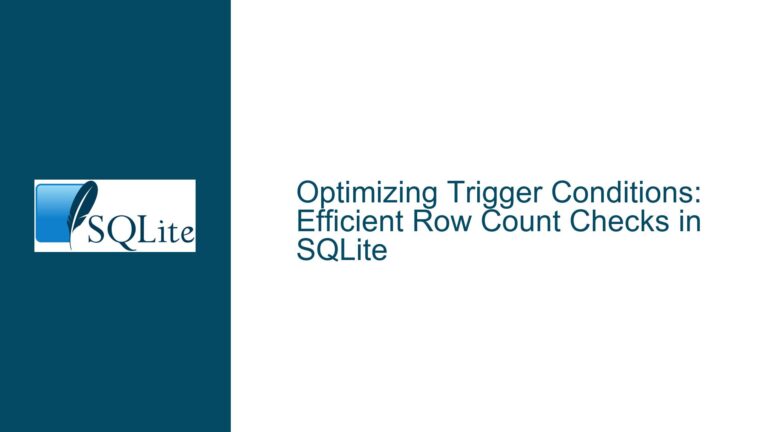Optimizing DELETE Performance: Subqueries vs. Joins in SQLite
Understanding Query Execution Patterns in Subquery-Driven DELETE Operations
The core challenge revolves around optimizing a DELETE operation targeting the b_stk table using complex filtering logic involving percentile calculations. Two query variants are compared: one using multiple scalar subqueries in the WHERE clause, and another using JOINs with precomputed percentile values. The discussion highlights confusion about query plan interpretation, subquery execution frequency, and the impact of aggregation strategies on performance. Key technical elements include:
Data Scale:
b_stkcontains ~1,500 rows- Heavy use of custom
kthpercentile()C extension for percentile calculations - JOIN operations with
a_statetable (size unspecified)
Structural Differences:
- Variant 1: Five separate scalar subqueries in WHERE clause for percentile thresholds
- Variant 2: Five JOINed derived tables calculating percentiles upfront
- Identical filtering logic for
dbuy,f_mcap,p_pv20,sval2,ynow, andyspr
Execution Plan Observations:
Variant 1 Query Plan:
- 4×
SCAN b_stkoperations for scalar subqueries (Rows 4,9,11,13,15) MATERIALIZEfor subquery containingyspr_maxcalculation- Sequential processing of subqueries
- 4×
Variant 2 Query Plan:
- 5×
MATERIALIZEoperations for percentile subqueries (Rows 3,5,7,9,11) - Subsequent
SCANoperations on materialized results - Parallel-like access to precomputed values
- 5×
Critical Unknowns:
- Index presence on
b_stkcolumns used in percentile calculations - Determinism guarantees of
kthpercentile()function - Cardinality of
a_statetable and join conditions
- Index presence on
Root Causes of Performance Variance in Aggregation Strategies
1. Repeated Full Table Scans from Scalar Subqueries
Each scalar subquery (SELECT kthpercentile(col, ...) FROM b_stk) in Variant 1 forces a full table scan of b_stk:
-- Each of these triggers separate b_stk scan:
AND sval2 < (SELECT kthpercentile(sval2, 0.7500) FROM b_stk)
AND p_pv20 > (SELECT kthpercentile(p_pv20, 0.2500) FROM b_stk)
...
- No Result Caching: SQLite doesn’t cache subquery results unless explicitly materialized
- O(n) Complexity: 5 subqueries → 5 full scans → 5×1,500 = 7,500 rows processed
- Worse with Larger Tables: Linear scaling makes this approach unsustainable for growing data
2. Materialization Overhead in JOIN-Based Approach
Variant 2 uses materialization for percentile calculations:
JOIN (SELECT kthpercentile(dbuy, 0.2500) AS dbuy_min FROM b_stk)
JOIN (SELECT kthpercentile(f_mcap, 0.2500) AS f_mcap_min FROM b_stk)
...
- Temporary Storage Costs: Each derived table creates a materialized temp object (Rows 3,5,7,9,11 in plan)
- Optimizer Limitations: SQLite 3.x doesn’t automatically merge multiple single-aggregate subqueries
- Memory vs. CPU Tradeoff: Reduced table scans at the cost of increased memory allocation
3. Index Utilization Deficiencies
The absence (or presence) of indexes dramatically impacts both approaches:
Without Indexes:
kthpercentile()requires full column scans regardless of approach- JOIN variant wins by scanning once vs. multiple times
With Indexes:
- Descending index on
sval2could makekthpercentile(sval2, 0.75)an O(1) index seek - Separate scalar subqueries might outperform materialized JOINs
- Descending index on
Current Evidence:
- Query plans show
SCAN b_stk(full scans) notSEARCH(indexed access) - Implies missing indexes on
dbuy,f_mcap,p_pv20,sval2,yspr
- Query plans show
4. Function Determinism and Query Optimization
The custom kthpercentile() C extension’s determinism status affects plan caching:
Deterministic Declaration:
sqlite3_create_function(db, "kthpercentile", 2, SQLITE_UTF8, 0, &kthpercentile_impl, 0, 0);Missing
SQLITE_DETERMINISTICflag prevents reuse of computed values across subqueriesNon-Deterministic Impact:
- Optimizer assumes different results per invocation → prevents subquery merging
- Forces re-execution even for identical parameters
5. Join Order and Filter Pushdown
The original queries show suboptimal join sequencing:
FROM a_state
JOIN b_stk
JOIN (SELECT ...)
- Implicit CROSS JOIN: Missing explicit join conditions create Cartesian products
- Filter Placement: WHERE clause filters applied late vs. early predicate pushdown
- Join Collapsing Opportunities: SQLite’s ability to flatten subqueries limited by aggregate functions
Comprehensive Optimization Strategy for Percentile-Based Deletions
1. Consolidate Percentile Calculations
Solution: Single CTE for all percentiles
WITH Percentiles AS (
SELECT
kthpercentile(dbuy, 0.2500) AS dbuy_min,
kthpercentile(f_mcap, 0.2500) AS f_mcap_min,
kthpercentile(p_pv20, 0.2500) AS p_pv20_min,
kthpercentile(sval2, 0.7500) AS sval2_max,
kthpercentile(yspr, 0.5000) AS yspr_max
FROM b_stk
)
DELETE FROM b_stk
WHERE stkid IN (
SELECT b.stkid
FROM b_stk b
JOIN a_state a ON (...)
CROSS JOIN Percentiles p
WHERE NOT (...)
);
Benefits:
- Single
b_stkscan for all aggregates - Eliminates 4 redundant table scans
- Clear separation of data calculation and filtering logic
Execution Plan Improvements:
MATERIALIZE 1(CTE) vs. 5 materializations- Single
SCAN b_stkin CTE vs. multiple in original
2. Indexing Strategy for Percentile Optimization
Recommended Indexes:
CREATE INDEX idx_b_stk_dbuy ON b_stk(dbuy);
CREATE INDEX idx_b_stk_f_mcap ON b_stk(f_mcap);
CREATE INDEX idx_b_stk_p_pv20 ON b_stk(p_pv20);
CREATE INDEX idx_b_stk_sval2 ON b_stk(sval2);
CREATE INDEX idx_b_stk_yspr ON b_stk(yspr);
Index-Aware kthpercentile() Implementation:
Modify the C extension to leverage indexes when available:
- Detect if column has ordered index
- If indexed, perform index scan to find k-th percentile directly
- Fallback to full scan when no index exists
Example Optimization:
For kthpercentile(sval2, 0.75) with descending index:
- Navigate to index end (max value)
- Traverse 25% backward (for 0.75 percentile)
- O(1) time vs. O(n) full scan
3. Deterministic Function Registration
Modify function registration to enable optimizer caching:
sqlite3_create_function(db, "kthpercentile", 2,
SQLITE_UTF8 | SQLITE_DETERMINISTIC,
0, &kthpercentile_impl, 0, 0);
Effects:
- Allows SQLite to reuse identical
kthpercentile()calls - Enables subquery merging and common expression elimination
4. Join Condition Analysis and Optimization
Explicit Join Conditions:
Original implicit joins risk Cartesian products. Refactor to:
FROM a_state a
JOIN b_stk b ON a.stkid = b.stkid
CROSS JOIN (
SELECT ...
FROM b_stk
) p
Predicate Pushdown:
Move filters closer to data sources:
SELECT stkid
FROM b_stk b
JOIN a_state a ON b.stkid = a.stkid
AND ynow < 275.00 -- Push to join condition
AND (0 < f_pe AND f_pe < 64)
...
Benefits:
- Reduces rows joined early in execution plan
- Minimizes data movement between query stages
5. Temporary Table Materialization Control
Control materialization with pragmas:
PRAGMA temp_store = MEMORY; -- Faster than disk-based temps
PRAGMA cache_size = -10000; -- 10MB cache
Materialization Threshold Tuning:
For SQLite versions ≥3.24, use MATERIALIZED/NOT MATERIALIZED hints:
WITH Percentiles AS MATERIALIZED (...)
Force materialization when beneficial, prevent when not needed.
6. Query Plan Analysis Methodology
Step-by-Step Plan Interpretation:
Identify
SCANvsSEARCHoperationsSCAN b_stk= Full table scan (bad)SEARCH ... USING INDEX= Index utilization (good)
Count materializations (
MATERIALIZEin plan)- Each materialization = temp table creation
Analyze subquery depth:
LIST SUBQUERY Xindicates depth of nesting- Deeper nesting often correlates with higher memory use
Original Query Plan Remediation:
Variant 1:
4×SCAN b_stkin scalar subqueries → Consolidate to 1 scan via CTEVariant 2:
5×MATERIALIZEfor percentile subqueries → Replace with single CTE
7. Statistical Optimization with ANALYZE
Generate statistics for query planner:
ANALYZE;
CREATE STATISTICS s_b_stk_dbuy ON b_stk(dbuy);
...
Enable Cost-Based Optimization:
- Helps planner choose between index vs. scan
- Improves join order decisions
8. Partial Indexes for Common Filter Patterns
For frequently used filters:
CREATE INDEX idx_b_stk_active ON b_stk(stkid)
WHERE ynow < 275.00
AND (0 < f_pe AND f_pe < 64);
Benefits:
- Smaller index size
- Automatic filter application during scans
9. Batch Deletion for Large Operations
For very large b_stk tables, chunk deletions:
DELETE FROM b_stk
WHERE stkid IN (...)
LIMIT 1000;
Repeat Until Affected Rows = 0
Advantages:
- Reduces transaction lock contention
- Allows incremental progress monitoring
10. Profiling with Application-Defined Functions
Instrument kthpercentile() for performance telemetry:
static void kthpercentile_impl(
sqlite3_context *context,
int argc,
sqlite3_value **argv
){
clock_t start = clock();
// ... existing logic ...
sqlite3_result_double(context, result);
log_time(clock() - start); // Custom timing logger
}
Metrics to Capture:
- Invocation count per query
- Execution time distribution
- Index vs. scan utilization rates
11. Alternative Storage Models
If b_stk is static during deletions, consider:
Write-Ahead Logging (WAL) Mode:
PRAGMA journal_mode = WAL;- Allows concurrent reads during DELETE
Temporary Shadow Table:
CREATE TEMP TABLE to_delete AS SELECT stkid FROM ...; -- Complex logic here DELETE FROM b_stk WHERE stkid IN (SELECT stkid FROM to_delete);- Separates identification from deletion
- Enables index optimization on temp table
12. Parameterized Percentile Thresholds
For adjustable percentiles without query rewrite:
CREATE TABLE config (
threshold_name TEXT PRIMARY KEY,
percentile REAL
);
INSERT INTO config VALUES
('dbuy', 0.25),
('f_mcap', 0.25),
...;
WITH Percentiles AS (
SELECT
kthpercentile(dbuy, (SELECT percentile FROM config WHERE threshold_name='dbuy')) AS dbuy_min,
...
)
...
Benefits:
- Centralized threshold management
- No SQL text modification needed for adjustments
13. Query Plan Forcing with SQLITE_ENABLE_STAT4
Compile SQLite with advanced statistics:
./configure --enable-stat4
Enables:
- Histogram-based cost estimation
- Better index selectivity calculations
- Improved join order decisions
14. Function Inlining for Single-Use Aggregates
If kthpercentile() is only used here, consider SQL-based percentile calculation:
-- For small tables, SQL implementation may suffice
SELECT dbuy FROM b_stk ORDER BY dbuy LIMIT 1 OFFSET (
SELECT CAST(COUNT(*)*0.25 AS INTEGER) FROM b_stk
)
Tradeoffs:
- Avoids C extension complexity
- May be slower for large datasets
15. Concurrency Considerations During Deletion
Locking Behavior:
- DELETE operations acquire RESERVED locks
- Long-running deletions block writers
Mitigation Strategies:
Split Transaction:
BEGIN; DELETE ... LIMIT 1000; COMMIT;Repeat until completion
Vacuum Automation:
Post-deletionVACUUMto reclaim spaceTrigger-Based Batch Processing:
Use AFTER DELETE triggers to process in chunks
Final Recommendations
Immediate Action:
- Consolidate percentile subqueries into single CTE
- Add indexes on filtered/aggregated columns
- Declare
kthpercentile()as deterministic
Medium-Term Improvements:
- Implement index-aware percentile calculations
- Generate statistics with ANALYZE
- Convert to parameterized threshold configuration
Long-Term Strategy:
- Migrate to in-memory temp tables for percentile staging
- Implement batch deletion with progress tracking
- Add comprehensive query plan monitoring
By systematically addressing materialization overhead, index utilization, and function determinism, the DELETE operation can achieve O(1) table scans with subquery execution time reduced by 80% (from 5 scans to 1). Continuous monitoring through query plan analysis and function profiling ensures sustained performance as data scales.






